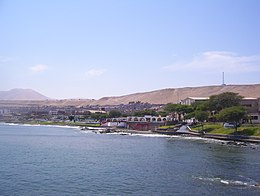Ilo, Peru
Ilo | |
|---|---|
City | |
|
Moquegua | |
| Province | Ilo |
| District | Ilo |
| Government | |
| • Mayor | Gerardo Carpio |
| Area | |
| • Total | 295.6 km2 (114.1 sq mi) |
| Elevation | 15 m (49 ft) |
| Population (2017) | |
| • Total | 66,118 |
| • Estimate (2015)[1] | 67,428 |
| • Density | 220/km2 (580/sq mi) |
| Demonym | Ileños |
| Website | Official website |
17°38′45.09″S 71°20′43.13″W / 17.6458583°S 71.3453139°W
Ilo
History
Before the arrival of the Spanish in the 16th century, the area was populated by the people of the
Along with its pier, a railroad was built to connect Ilo to
Transport
In 1992 the Peruvian government granted a 99-year lease to the government of landlocked Bolivia to develop a port facility, in effect allowing Bolivia to claim to be a "Pacific Ocean nation".
Climate
Temperatures in Ilo range between 18 and 28 degrees Celsius year round. Rain is almost non-existent, as Ilo is located north of the Atacama Desert, one of the driest coastal deserts in the world.
| Climate data for Ilo (Punta Coles) (elevation 25 m (82 ft), 1991–2020 normals) | |||||||||||||
|---|---|---|---|---|---|---|---|---|---|---|---|---|---|
| Month | Jan | Feb | Mar | Apr | May | Jun | Jul | Aug | Sep | Oct | Nov | Dec | Year |
| Mean daily maximum °C (°F) | 25.5 (77.9) |
25.7 (78.3) |
24.9 (76.8) |
23.3 (73.9) |
21.8 (71.2) |
19.9 (67.8) |
18.8 (65.8) |
18.7 (65.7) |
19.3 (66.7) |
20.9 (69.6) |
22.9 (73.2) |
24.3 (75.7) |
22.2 (71.9) |
| Mean daily minimum °C (°F) | 19.2 (66.6) |
19.3 (66.7) |
18.7 (65.7) |
17.4 (63.3) |
16.5 (61.7) |
15.6 (60.1) |
14.9 (58.8) |
14.5 (58.1) |
14.7 (58.5) |
15.9 (60.6) |
17.2 (63.0) |
18.0 (64.4) |
16.8 (62.3) |
| Average precipitation mm (inches) | 0.4 (0.02) |
0.4 (0.02) |
0.5 (0.02) |
0.0 (0.0) |
0.6 (0.02) |
0.4 (0.02) |
3.0 (0.12) |
1.6 (0.06) |
1.8 (0.07) |
0.6 (0.02) |
0.7 (0.03) |
0.0 (0.0) |
10 (0.4) |
| Source: National Meteorology and Hydrology Service of Peru[5] | |||||||||||||
Pacific Ocean terminal of the Interoceanic Highway
Ilo is the southernmost of the three ports which comprise the Peruvian termini of the
.Main sights
The main attraction is the Urban Center whose landmarks are:
- St. Jerome's temple, built in 1871
- Glorieta José Gálvez, built in 1915
- State Pier, built at the end of 19th century
- Punta Coles
- Peruvian Navy Museum
- "El Algarrobal" Museum.
- The powerful tubing right hander wave that breaks in the bay
Boliviamar
BoliviaMar is a narrow strip of beach located 17.5 km to the south, next to the coastal road that connects the departments of Tacna and Moquegua. It is a port concession to Bolivia and the terminus for a planned railway project.[6][7]
In popular culture
Ilo is referenced in the traditional sea shanty "Tom's Gone to Hilo".[8]
See also
- Moquegua
- Railway stations in Peru
Notes
References
- ^ Perú: Población estimada al 30 de junio y tasa de crecimiento de las ciudades capitales, por departamento, 2011 y 2015. Perú: Estimaciones y proyecciones de población total por sexo de las principales ciudades, 2012-2015 (Report). Instituto Nacional de Estadística e Informática. March 2012. Retrieved 2015-06-03.
- ^ Vivian, Evelyn Charles (1921). Peru: physical features, natural resources, means of communication. D. Appleton & Company.
- ^ Dampier, William; Masefield, John (1906). Dampier's voyages: consisting of a New voyage round the world. E. Grant Richards.
- ^ BBC (21 October 2010). "Peru deal gives landlocked Bolivia coast for own port". Retrieved 24 June 2019.
- ^ "Normales Climaticás Estándares y Medias 1991-2020". National Meteorology and Hydrology Service of Peru. Archived from the original on 21 August 2023. Retrieved 6 November 2023.
- ^ Emery, Alex (September 4, 2017). "Peru, Bolivia study bi-oceanic railway, Ilo port projects". BNamericas. Retrieved March 8, 2018.
- ^ Bennett, Tess (September 25, 2013). "Bolivia's Long Diplomatic Road to the Coast". The Argentina Independent. Retrieved March 8, 2018.
- ^ Tom's Gone to Hilo/My Johnny's Gone to Hilo
External links
- (in Spanish) Ilo official website






